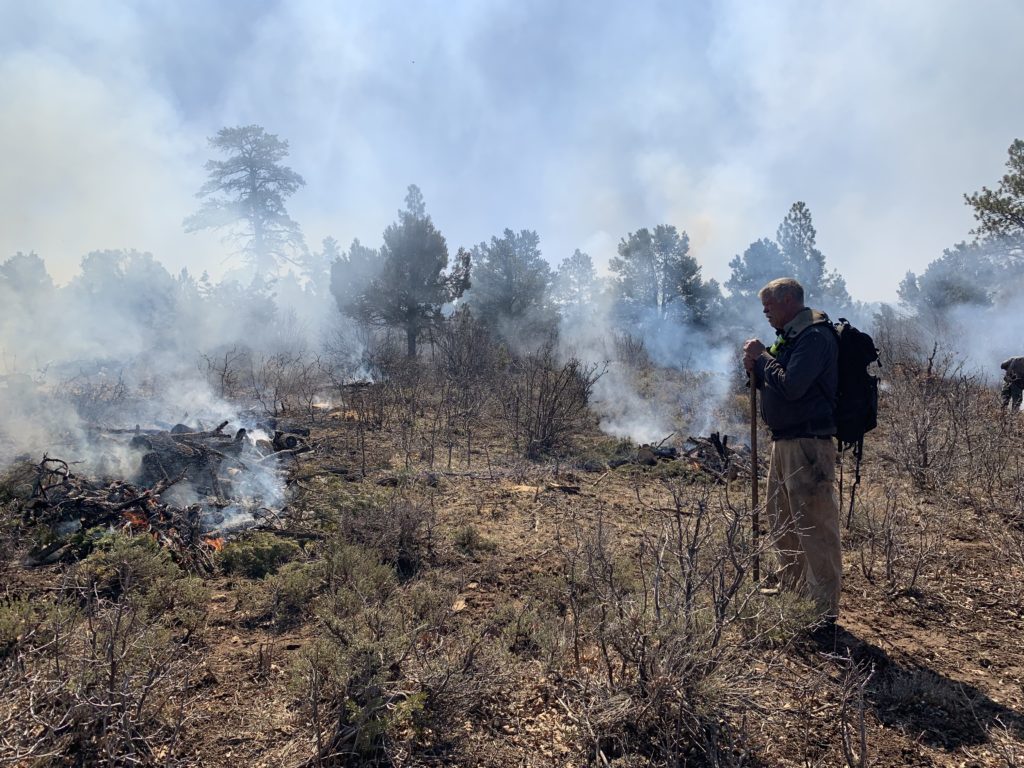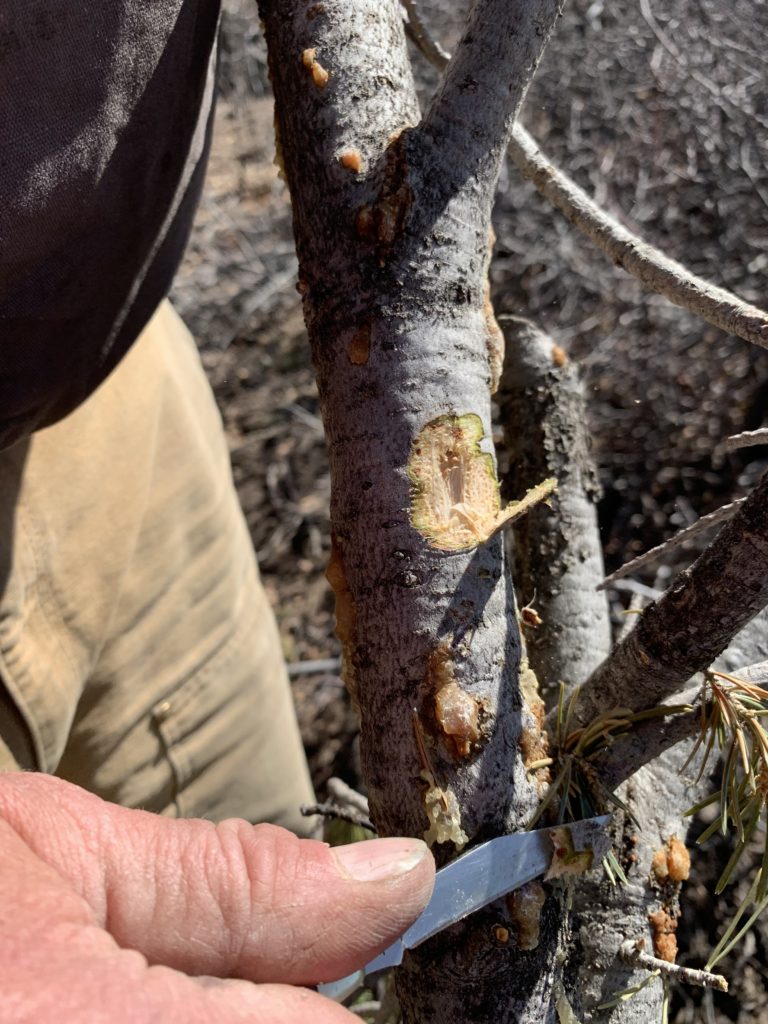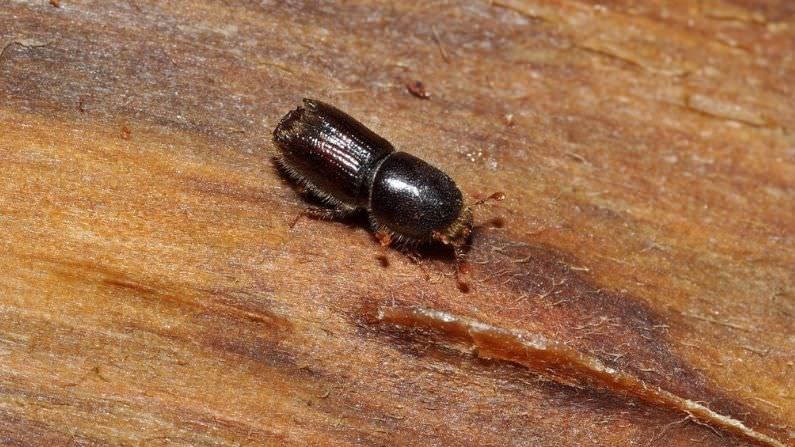This story comes to KHOL through the Rocky Mountain Community Radio coalition.
On a mild spring day in Southwest Colorado, Steve Underwood and his crew are tending to burning piles of pinyon pine.
“The green needles are burning, but the interior heavy stuff is not burning as well,” he said. “There’s a real art to this to be able to burn it and not have it creep around.”
Underwood is a forestry and fire management expert. He specializes in prescribed burns like this one near the San Juan National Forest
“These are all pinyons that have been infested with ips beetles,” he said. “So, we cut these down last winter, and we pile them. And now we’re going to burn the piles so that we can get rid of its population on this parcel.”

Steve Underwood, a forest management expert, manages a prescribed burn near the San Juan National Forest. Burns are one way to mitigate ips beetle infestations, but they won’t solve the root problems driving the bugs’ spread. (Lucas Brady Woods/KSJD)
The ips beetle, or more specifically the pinyon ips beetle, is an insect that colonizes pinyon pines. Even though the bugs are tiny, only about an eighth of an inch long, they can still kill trees. The burrows they carve in a tree’s bark can eventually cut off its flow of nutrients. And, according to Underwood, ips beetle outbreaks are happening in parts of the region they haven’t reached before.
“Climate change is providing more habitat for the ips beetles,” he said. “They’re moving north. They’re killing trees.”
Underwood’s not the only person noticing the drought-induced beetle outbreaks. Amy Lockner is an entomologist with the U.S. Forest Service who specializes in bark beetles like the ips.
“They are picking away at our forests now that we’re in this continuous drought state,” she said.
She also said that despite the ips beetle’s potentially damaging impact on trees, it’s nothing new to the region.
“It’s native,” she said. “So, [it] has been here way longer than any of us have been. It evolved with the pinyon trees.”
For example, pinyons have developed a defense mechanism against the ips–the resin they produce underneath their bark.
When beetles attack a tree, “the tree actually releases that resin and it kind of acts like a water hose,” Lockner said. “And it pushes those beetles out.”

Steve Underwood looks for ips beetles in a pinyon branch. The insects burrow into the bark of a tree to lay their eggs and can cut of the flow of nutrients keeping a tree alive in the process. (Lucas Brady Woods/KSJD)
But the trees need access to enough water to create that resin. So if conditions are too dry, they aren’t able to defend themselves. And during widespread drought, when large numbers of trees don’t have enough water, beetles spread more easily from tree to tree.
“The beetles basically just walk right in, and then they talk to each other with pheromones,” Lockner said. “And that basically says, ‘Parties here, come on in.’ So, those attract more beetles.”
Outbreaks fueled by drought are not unique to ips beetles, though. Drought is one contributing factor in the spread of other bark beetles like the spruce beetle, which is responsible for killing large areas of spruce forest in the Rocky Mountains. According to Lockner, the spruce beetle has spread so widely that it’s running out of trees to colonize.
But the spread of pinyon ips isn’t to that point yet. And Lockner said there are ways to help mitigate beetle outbreaks, even on the level of individual properties.
Mirenda Yates is one Southwest Colorado landowner who is taking action. That prescribed burn Steve Underwood was working on earlier–that’s her land.
“Saving the trees that you can, tree health, fire mitigation, things like that,” Yates said. “For me, they’re the most important thing about being a land steward.”
Yates started working on conservation and forest rehabilitation on the land as soon as she bought it. But keeping a landscape healthy takes more than just one prescribed burn. It’s a long-term, ongoing process.
“In my mind, I’m looking at 10 to 15 years,” Yates said. “So, these are definitely long-term goals. And then the beetles were really important one to start with because they can be so devastating.”
At the end of the day, Lockner said pinyon ips aren’t going anywhere. And that’s a good thing. When populations are at a healthy level, they serve an important role in the ecosystem.
“They act as kind of our natural recyclers,” Lockner said. “In an endemic state, they’re just attacking the weak trees, the old, the dying trees. So, they do a really good job of thinning our forests.”
But for that to happen, drought conditions will need to subside in the region, ideally through better winter snowpack and summer monsoon rains.
Underwood Forestry is one of KSJD’s financial supporters.






